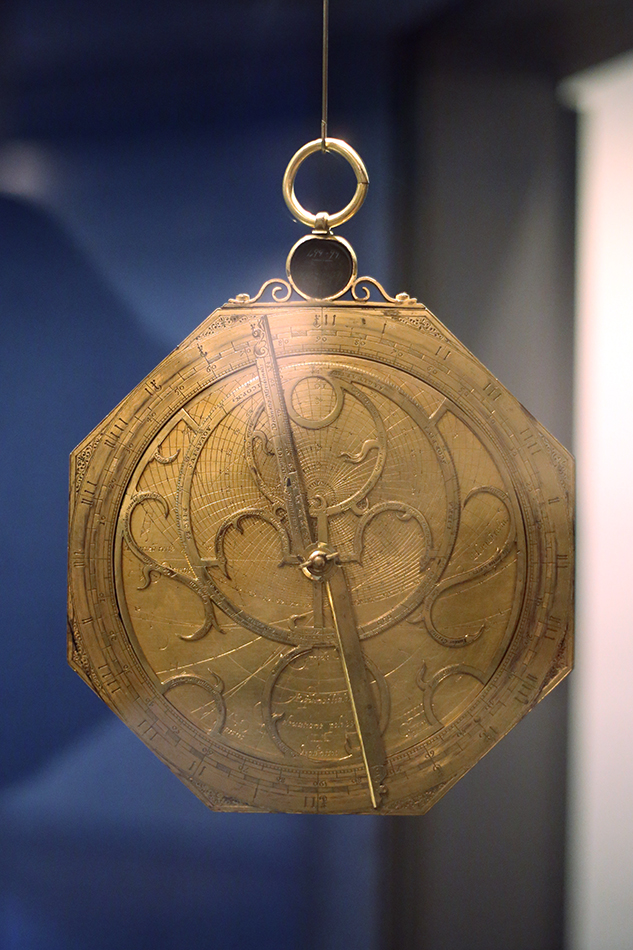
Although time and its measurement is a fundamental component of human life, a special type of clock which takes matters to the next level is the so-called
astronomical clock and whose purpose is not to measure time per se but to convey astronomical information and, in particular, the relative position of the
Sun and Moon as well as the zodiacal constellations and, in some cases, the position of the planets all as a function of time.
The oldest such effort to effectively emulate the overhead celestial sphere (ie a mini-planetarium) is the
Antikythera Mechanism which was discovered in 1901 totally by
accident by sponge divers off the coast of the Greek island of Antikythera. It has been dated to approximately 80 BC and it is believed to be the work of
Poseidonius of Rhodes. The Antikythera Mechanism is currently on display
at the National Archaeological Museum in Athens, Greece.
Note: The astrolabe is yet another instrument constructed to describe the overhead sky and monitor time. Some versions also
have religious implications such as the Muslim Qibla where a magnetic compass on the back side of the astrolabe helps the user identify the proper orientation
so as to point at the holy city of Mecca for prayer. Astrolabes were first developed by the Greeks around the second century BC and were slowly adopted
throughout the known world of the time by numerous cultures. Astrolabes describe the position of the planets and prominent stars visible at a particular
latitude (see curved markings on each dial in the photo below) and, by extension, act as time-keeping devices. Similarly, they assist in the time of expected
sunrise which is vital for the Muslim religion and the timing of morning prayers at dawn ("fajr") and thereafter at noon ("dhuhr"), afternoon ("asr"), sunset
("maghrib") and nightfall ("isha"). As a result, it is no surprise that the overwhelming number of astrolabes found in museums around the world are
islamic in origin given the adoption of these instruments from around 700 AD and thereafter by the Islamic World. Today's planispheres can be said to be a
direct extension of the ancient astrolabe, for they function and inform the user of precisely the same information sought-after by users many centuries ago.
The copper gilt astrolabe below with impressive engraving and detail is on display at the National Museum of Ireland in central Dublin.
It is credited to Jacob Habermal (1538-1606) of Prague and was constructed around 1592 for Dr Franciscus Paduanicio who was the personal physician of Rudolf II
(Holy Roman Emperor between 1576-1612). As can be seen by the photo, it is particularly unique due to its octagonal shape with a height of 240mm (with crown) and
a width of 180 mm and is prominently displayed at the Decorative Arts & History Museum, in Dublin. Habermal was recognized for the construction of scientific
instruments associated with superb workmanship and was considered one of the finest craftsmen in his day with various museums currently having at least thirty of
his works in their collections. The astrolabe below also included three latitude plates and, as a result, is planespheric in nature, for it projects the
three-dimensional celestial sphere onto a two-dimensional plane comprised of metal plates with the latter correcting for differences due to latitude. During the
Middle Ages, three-dimensional astrolabes were first described but only one such example seems to have survived to present day and which can be found at the
History of Science Museum in Oxford, England.
The National Museum of Ireland in Dublin is a complex of four venues comprised of the "Decorative Arts & History Museum", the "Country Life Museum", the
"Natural History Museum" and the "Archaeology Museum" interspersed throughout Dublin. The astrolabe below is on display at the Decorative Arts & History Museum
in central Dublin which is open daily with free admission (Tuesday to Saturday: 10:00-17:00, Sunday to Monday: 13:00-17:00) and is a very brief walk from the
"Museum" tram stop (Red Line).
Note: For an impressive view of the back side of the astrolabe, please click
here.
Note: For additional results involving astronomical clocks and astrolabes from around the world, please click
here.
|
Body: Sun Mass: 332,900 x Earth Mass Eq Diameter: 109.1 x Earth Distance: 149 million km RA / Dec: 23h 41m 41s / +89° 19' 51" Diameter: 32.16' Magnitude: -26.8 |
 |
Date: Apr 04, 2024 Location: National Museum of Ireland, Dublin, Ireland Equipment: Canon EOS 6D Baader BCF2 Filter Canon EOS EF 50mm/f1.8 USM @ f1.8 Exposure: 1 x 1/80 sec ISO 6400 JPG Fine Image Format 5472x3648 Image Size Custom White Balance Continuous Servo Mode Manual Mode Software: Photoshop CS6 Processing: White Balance Adjustment Cropping (15%) Resampling JPG Compression |